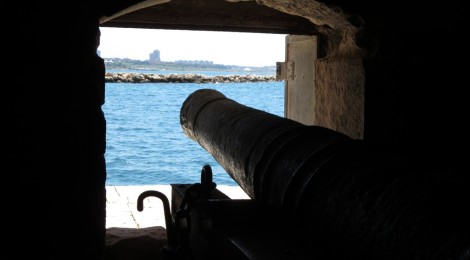
Italian Double-Take: Aragon Castle, Taranto
“Often we pass beside happiness without seeing it, without looking at it, or even if we have seen and looked at it, without recognizing it.”
— Alexander Dumas, The Count of Monte Cristo
“Wait, where are we again,” I ask, only half joking, disconnected from the name of the southern Italian city where we just spent the night.
“Taranto,” Chris reminds me.
Right. Taranto.
Our original hope was to avoid the Taranto overnight and only pass through as part of a marathon day of travel from Palermo on the western coast of Sicily, to Brindisi on the eastern coast of mainland Italy in time to catch a night ferry to Greece. The connections didn’t sync up, however, and so here we are in the commercial and military port town of Taranto on the bottom of the Italian boot, where heel meets instep.
It was 7pm when we arrived and, after a quick take-out pizza dinner, we holed up in our hotel room to prep for Greece, making Greek phrase flash cards, booking a room and researching bus routes from the ferry dock in Patras to central Athens. This morning we sipped our last cappuccini, said our goodbyes to Italy, strapped on our bags and got an early start toward the train station.
Now halfway there, we reach a pedestrian promenade overlooking the sea and the Aragon Castle, a four towered fortress which looks much more impressive than it did on our evening arrival walk last night. A banner secured to the pedestrian bridge advertises free daily castle tours. The next tour starts in fifteen minutes. On a whim, we make a detour and head for the gates. At least we’ll have a point of reference to remember we were here.
At the castle gates we are greeted warmly by representatives of the Italian Navy in full uniform, who now own and actively base out of the castle. (In 2005, we later learn, the municipality of Taranto went bankrupt, politicians did time and the castle was turned over the Navy). We sign forms, leave our bags in the Italian Navy’s care, and join a small tour group about to depart.
Our guide is a spry Chief Petty Officer with eyes that twinkle like the Mediterranean, and a goatee that helps bring the castle’s history to life as he demonstrates, for example, how weapons would have been aimed through the castle’s narrow embrasures. He talks with grand hand and arm gestures as he hops linguistically back and forth, translating in English, Italian and French with as much agility and wit as a musketeer winning a fencing duel.
The castle, now exquisitely and swashbuckling restored by the Italian Navy, was built by order of Ferdinand, king of Aragon as a defensive structure, completed in 1492 and, later during the XVIII century, used as a prison. Poised in an atmospheric alcove displaying a cannon pointed seaward, our guide pauses dramatically to tell a story. The father of writer Alexander Dumas was a French military colonel who once spent an hour and a half as a prisoner in the castle before his freedom was swiftly negotiated. While Alexander never saw the prison, it is reasonable, our guide suggests, to assume that a father would have told his son stories of his time behind Aragon bars, and to further assume that these tales likely helped inform the high-profile prison scenes in The Three Musketeers and The Count of Monte Cristo. Not a bad literary return for an hour and a half.
The tour, like a riveting adventure novel, ends too quickly. Leaving the castle, we opt for a longer route toward the train station through the winding alleys of the old town. The stone walls are honey toned in the early afternoon light. A merry band of young men carries a green velvet couch through the narrow backstreets with beer bottles in their free hands. A chef sits on a low stool debearding fresh mussels. A green grocer sweeps his stoop. Everyone greets us as we pass with “buonasera” or “ciao.”
Our Chief Petty Officer was right: in an hour and a half, Taranto can leave a long-lasting impression.
(Belatedly) recognizing happiness,
Alison





Recent Comments